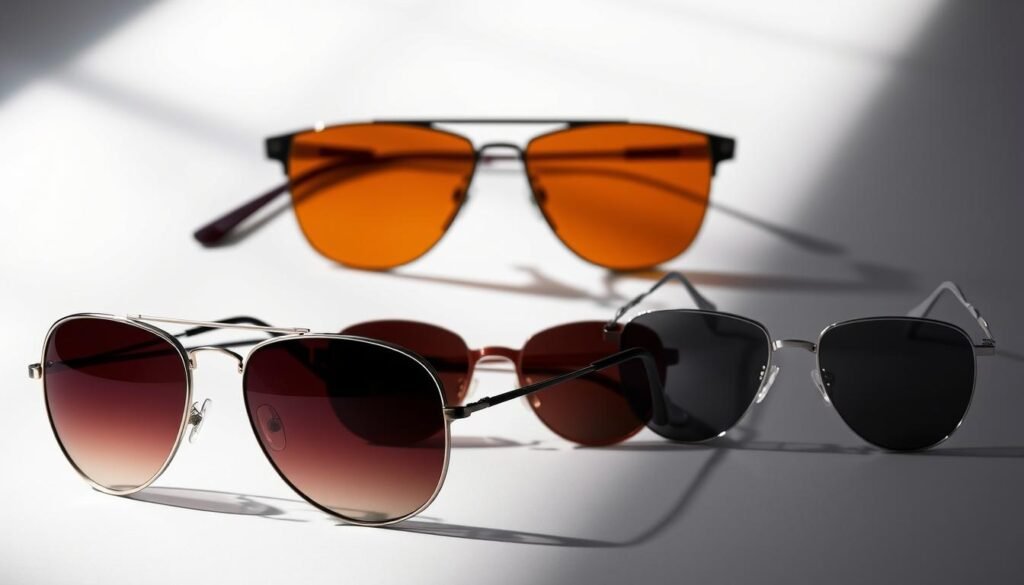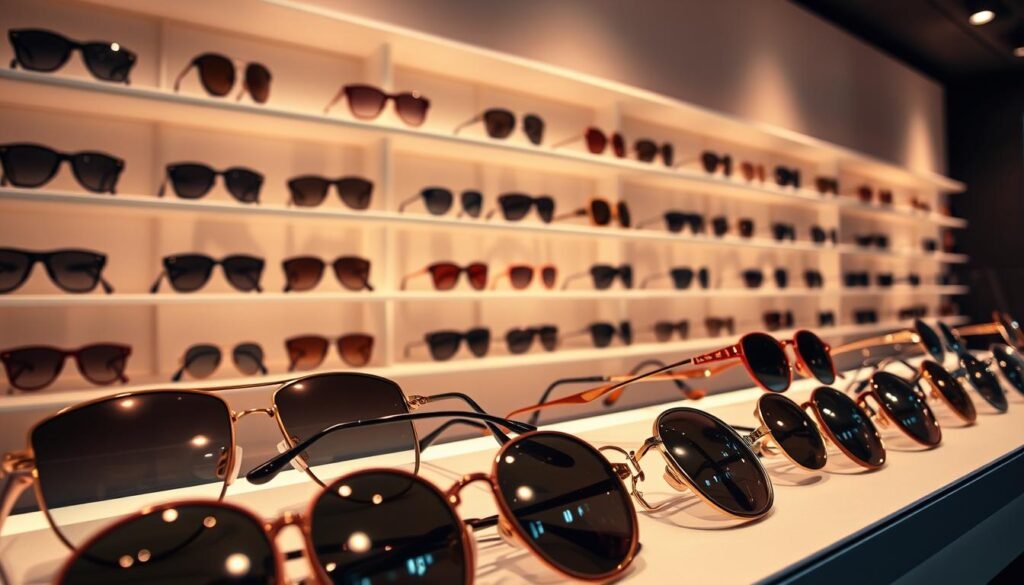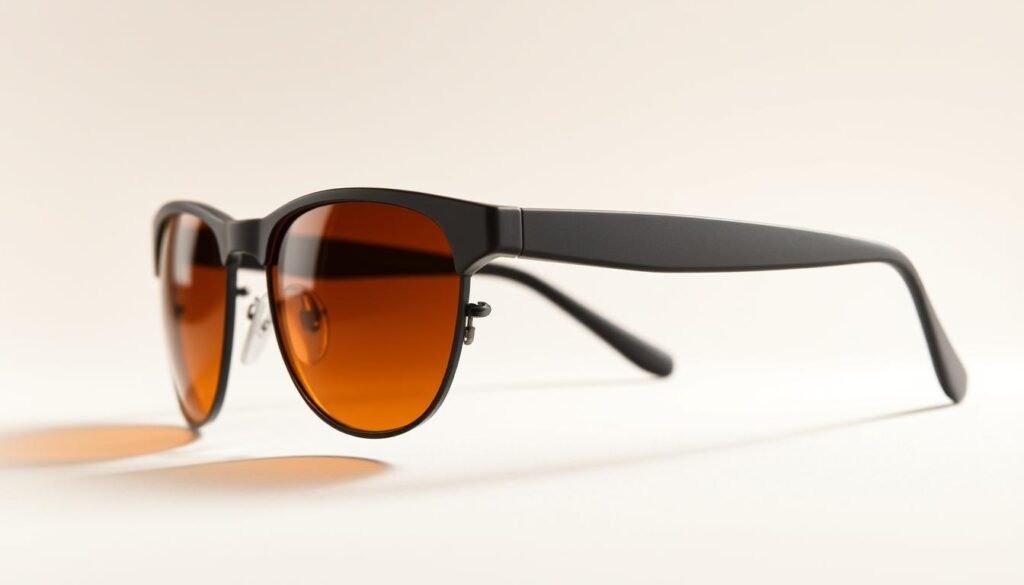Choosing the right pair of shades goes beyond style. The best options shield your eyes from harmful UV rays while offering lasting comfort. Premium materials like cellulose acetate and polarized lenses define true excellence in eyewear, blending durability with crisp vision.
Superior lens technology plays a critical role. Look for options blocking 100% of UVA/UVB rays. Polarized versions reduce glare, making them ideal for driving or water activities. Combined with impact-resistant frames, these features ensure your eyes stay safe in various conditions.
Comfort matters as much as protection. Lightweight designs with adjustable nose pads prevent slipping. Flexible hinges allow frames to move naturally with your face. Whether you prefer classic aviators or modern wraparound styles, the right fit enhances daily wear.
Key Takeaways
- UV protection is non-negotiable for preventing long-term eye damage
- Polarized lenses reduce glare and improve visual clarity
- Durable frame materials like acetate withstand daily wear
- Comfort features include adjustable nose pads and flexible hinges
- Style choices should complement face shape and personal preferences
- Investing in premium options pays off through longevity and performance
Introduction to the World of Sunglasses
The evolution of eyewear mirrors cultural shifts and technological leaps. Early 20th-century shades served practical needs—aviators needed glare reduction, while movie stars sought anonymity. Today’s market blends heritage craftsmanship with space-age materials, creating pieces that protect and impress.
Modern designs span from retro round frames to angular geometric shapes. Sport-oriented wraparounds hug faces securely during hikes or cycling, while cat-eye glasses add vintage flair to urban outfits. This diversity reflects changing lifestyles and fashion’s endless reinvention.
“Eyewear design balances heritage with innovation—respecting the past while embracing new possibilities,” notes fashion historian Lena Cruz.
| Era | Iconic Styles | Primary Use |
|---|---|---|
| 1930s | Aviators | Military pilots |
| 1980s | Wayfarers | Pop culture statements |
| 2020s | Oversized shields | Streetwear & sports |
Brands now cater to niche preferences—think foldable travel sunglasses or blue-light-filtering computer styles. Whether you prioritize runway trends or all-day comfort, today’s options empower personalized choices without compromising eye safety.
Understanding Quality in Sunglasses
The essence of premium eyewear lies in its unseen engineering. Lens technology separates average pairs from exceptional ones—look for polycarbonate or glass options blocking 100% UV rays. Polarized versions combat glare without distorting colors, crucial for drivers and outdoor enthusiasts.
Frame durability depends on material choices. Acetate resists warping, while titanium offers featherlight strength. Precision-cut hinges should flex smoothly, avoiding the stiffness that leads to breakage. Test temple arms by gently bending them—quality construction springs back without creaking.
| Feature | Premium Standard | Budget Alternative |
|---|---|---|
| Lens Clarity | Zero distortion | Visible warping |
| UV Protection | 400nm blocking | Partial coverage |
| Hinge Action | 5000+ cycles | Loose after 1 year |
Evaluate nose pads through touch—silicone beats plastic for all-day comfort. Premium brands often include replaceable parts, extending eyewear lifespan. Remember: true quality reveals itself through daily use, not just store displays.
Key Features to Look For in Sunglasses
The difference between ordinary and exceptional eyewear lies in thoughtful details. Features that combine durability with wearability transform a simple accessory into a long-term companion for your eyes.
Materials and Construction
Frames made from TR90 plastic or cellulose acetate outperform budget options. Testing panels found warped frames in 43% of low-cost models, while these premium materials resisted bending and cracking. Hinges matter more than you think—stiff joints caused 28% of testers to abandon their pair within six months.
Design, Fit, and Comfort
A proper-fitting pair stays put without squeezing. Adjustable nose pads prevent sliding during workouts or windy days. Temple arms should cradle your ears like custom-molded supports—no red marks after hours of wear.
Look for frames that balance face proportions. Oversized lenses suit round faces, while angular cuts complement soft jawlines. Seamless edges and reinforced stress points show craftsmanship worth investing in. As one tester noted, “My daily pair now feels like part of my face—not a temporary fix.”
Trendy Designs and Style Evolution
Eyewear aesthetics constantly reinvent themselves while honoring their roots. GQ highlights how Ray-Ban’s aviator and Wayfarer shapes inspired bold reimaginings from brands like Jacques Marie Mage. Today’s market offers vintage revivals alongside futuristic frames that defy traditional expectations.

From Classic to Modern Shapes
Military-inspired teardrop shapes evolved into symbols of rebel cool. Designers now tweak proportions—think narrower bridges or elongated lenses—to refresh these icons. Akila’s reinterpretations pair heritage outlines with unexpected marbleized acetates.
Current trends split between minimalist elegance and daring statements. Oversized shields dominate streetwear, while geometric cuts attract avant-garde enthusiasts. As one Milan Fashion Week stylist observed, “Frames now serve as sculptural accents rather than mere sun blockers.”
| Era | Classic Feature | Contemporary Twist |
|---|---|---|
| 1930s | Wireframe aviators | Titanium matte finishes |
| 1960s | Cat-eye curves | Angular polycarbonate |
| 2020s | Round retro | Asymmetric geometrics |
Cyclical fashion ensures beloved styles return with modern upgrades. Brands balance nostalgia with innovations like flexible hinges or blue-light filtering. Choosing timeless designs with subtle updates ensures your eyewear stays relevant across seasons.
Comparing Frame Materials and Styles
Frame selection shapes both your look and daily experience. Recent tests reveal how materials and designs impact functionality—metal aviators often feel unbalanced, while budget plastic options lack refinement. Let’s explore what works across popular styles.
Aviator, Cat-Eye, and Round Perspectives
Metal aviators offer sleek profiles but risk structural weaknesses. Testing showed models like I-Sea Brooks tilting unevenly on faces. Plastic versions solve weight issues but may feel rigid—Sojos Retro’s stiff arms caused discomfort during extended wear.
Cat-eye frames prioritize aesthetics over durability. EyeBuyDirect’s warped lenses and fragile hinges highlight common pitfalls. Round styles balance vintage charm with modern versatility, though proper proportions prevent an overly theatrical look.
Square & Wayfarer Styles Compared
Square designs demand precise alignment. Blenders Sydney sat crookedly in tests, while acetate Kent Wang Knox models proved too narrow for full sunlight blocking. Wayfarers thrive in acetate, offering bold color options without sacrificing comfort.
| Feature | Metal Frames | Plastic Frames |
|---|---|---|
| Weight | Light but unstable | Sturdy yet flexible |
| Durability | Prone to bending | Resists daily wear |
| Style Options | Limited finishes | Vibrant colors/patterns |
Your face shape dictates success. Angular jaws soften with rounded frames, while oval faces handle geometric cuts. Always test fit—quality hinges should flex silently, and temples must grip without pressure points.
Product Roundup of Top Sunglasses Brands
From heritage icons to rule-breaking newcomers, eyewear brands offer distinct visions of style and function. Established names like Ray-Ban set industry standards, while fresh players challenge conventions with bold approaches. Let’s explore leaders shaping today’s market.

Ray-Ban remains unmatched in cultural influence. Their Wayfarer and Aviator designs have starred in films and street style for decades. These timeless silhouettes deliver reliable UV protection, making them a safe bet for your first premium pair.
For motorsport enthusiasts, Persol combines Italian precision with racetrack-ready durability. Foldable hinges and gradient lenses appeal to drivers needing seamless transitions between light conditions. Formula One legends often sport these sleek frames both on and off the track.
| Brand | Specialty | Audience |
|---|---|---|
| Oakley | Sports performance | MLB athletes |
| Jacques Marie Mage | Handcrafted exclusivity | Luxury collectors |
| Warby Parker | Affordable trends | Millennial shoppers |
Luxury seekers gravitate toward Jacques Marie Mage’s numbered editions. Each hand-polished acetate frame tells a story through intricate detailing. Meanwhile, Oliver Peoples revives vintage Hollywood glamour with modern lens coatings for urban environments.
Newcomers like Akila prove innovation thrives outside tradition. Their geometric shapes and marbleized finishes attract fashion risk-takers. Whether you prioritize legacy or disruption, today’s brands offer options aligning with personal values and aesthetics.
Innovative Materials in Modern Sunglasses
Today’s eyewear innovations merge science with environmental responsibility. Designers now craft frames using groundbreaking substances that protect both eyes and ecosystems. These advancements address durability concerns while reducing fashion’s carbon footprint.
Acetate, Recycled Plastic, and TR90
Cellulose acetate leads the bio-material revolution. Derived from cotton and wood fibers, this plant-based plastic retains vibrant hues for decades. Brands like Eco Belize pair it with recycled metal accents for eco-chic appeal.
TR90 thermoplastic reshapes active lifestyles. Tests show frames like Tifosi Svago withstand intense workouts without warping. While some models need hinge improvements, their featherlight feel makes them ideal for runners and cyclists.
| Material | Strength | Eco-Factor |
|---|---|---|
| Recycled Plastic | High impact resistance | 85% post-consumer waste |
| Cellulose Acetate | Flexible durability | Biodegradable elements |
| TR90 | Bend recovery | Long lifespan |
Unique Manufacturing Techniques
Modern production methods unlock new design possibilities. Laser-cut acetate allows intricate patterns unseen in mass-market pairs. Injection molding creates seamless recycled plastic frames that rival traditional builds.
Artisans now blend hand-polishing with 3D printing. This fusion preserves craftsmanship while achieving precise lens alignment. As one designer explains, “We’re rewriting rulebooks—mixing heritage skills with space-age tech.”
Durability and Longevity: Build and Performance
True durability in eyewear reveals itself through daily adventures rather than showroom promises. Testing exposes critical differences between short-lived trends and lasting companions for your eyes. Real-world challenges like accidental drops or sudden temperature changes separate robust designs from fragile pretenders.
Frame Strength and Hinges
Hinges make or break your eyewear’s lifespan. Models like EyeBuyDirect Safari showed stiff operation, while Tifosi Svago’s abrupt movements signaled poor engineering. Premium options use spring-loaded mechanisms that survive 10,000+ openings without wobbling. Temples should flex like gymnasts—bendable yet unbreakable, as seen in brands passing military-grade stress tests.
Lens Quality and Scratch Resistance
A crystal-clear lens means nothing if coatings peel after six months. PolarSpex models failed scratch tests with basic key exposures, while Kent Wang Aviators lost lenses during moderate impacts. Top performers combine hardened surfaces with secure mounting systems—look for brands using diamond-like carbon layers or ultrasonic welding techniques.
When evaluating frames, check stress points near hinges and nose bridges. Reinforced nylon inserts prevent warping that plagues budget options. Your perfect pair should handle years of beach trips, mountain hikes, and accidental couch landings without complaining.

